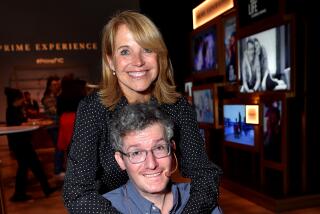Family Lives in Shadow of Lou Gehrig’s Disease
- Share via
BUFFALO, N.Y. — If you had only a few months left on Earth, what would you do?
If you could find out how you were going to die, would you?
These are “what ifs” that many people ponder casually at times.
But in Deneane Chiplock’s family, life regularly demands answers.
The family has been devastated by amyotrophic lateral sclerosis, or ALS, known as Lou Gehrig’s disease for the New York Yankee slugger who had it. The “creeping paralysis” that spares none of its victims has taken 24 lives in three generations.
Chiplock is the 25th to receive the deadly diagnosis. When the disease surfaced in November, the 39-year-old mother -- who as a teenager watched her mother die from ALS -- began to measure her life in months.
“My biggest fear in my whole life, other than losing one of my two children, was facing ALS,” she said. “Right now, I’m facing my worst fear ever.”
Given her family history and her own long battle with a connective tissue disease, Chiplock wanted to know long before her diagnosis whether ALS was in her future.
When researchers in 1994 isolated a defective gene and offered a blood test that would identify probable victims, Chiplock was among the first to take it. Her brother and sister -- each with the same 50-50 chance of having inherited the defective gene from their mother -- saw things differently. Chiplock’s sister, Anita Crawley, gave blood to the researchers but did not want to know whether she was likely to develop the disease. Their brother, Dennis Crawley, would not give blood, uneasy that such knowledge would be only a phone call away.
A positive reading for the defective gene means roughly a 90% chance of developing ALS.
“If somebody handed you a crystal ball and you could see in it what day you’re going to pass away and of what, would you want to see it?” Dennis Crawley asked. Almost everyone he knows says no. “That’s pretty much my feeling.”
Crawley, who collects Lou Gehrig memorabilia, does not want to know if he is a carrier because he would be helpless to change anything. No one knows how to prevent the onset of ALS, although some theories claim that vitamins and organic food could delay it.
“It’s not like some kind of cancer where early detection helps,” said the steelworker, 34. “With this, early detection just drives you nuts.
“It affects your life immensely, just the way you look upon everything,” Crawley said in the suburban Buffalo home that he shares with his wife, Jennifer, their children Justin, 9, and Ashley, 5, and a frisky Rottweiler-German shepherd mix.
Crawley wonders if he should take his kids to Disneyland now. If he waits, will it be too late?
Eventually, sister Anita would learn her results -- about seven years ago, after developing numbness in her hand, which turned out to be a pinched nerve. She feared that ALS was beginning to take hold and called for the results, reasoning that if they were negative, she could stop worrying.
She was told that she is a carrier.
Now Anita Crawley wonders at each twitch in her body whether ALS is coming to claim her.
“You look at your kids and say, ‘Is it going to be you?’ Did you give it to them?” she said.
She has a son and daughter, 6-year-old twins she’s rearing as a single nurse practitioner. The Buffalo hospital where she works recently encouraged employees to get their retirement plans in order. Anita Crawley doesn’t have one.
“Why do I need retirement? No one in the family lives that long,” she said.
Instead, she focuses on now, taking vacations with the twins every year, while there is still time.
She is about to turn 38, three years older than her mother was when she died, a year younger than her sister who now faces the disease.
Deneane Chiplock had medical decisions to make when she sought the blood test. If she knew she was a carrier, she would avoid treating her connective tissue disease with drugs that might trigger ALS.
Now that the disease is here, she spends her time organizing family paperwork, finishing household projects and creating “memory trunks” for Evan, 9, and Sean, 13, to hold photos, Christmas ornaments and recipes from the favorite meals she will no longer be able to make. Her day revolves around a regimen of vitamins and medications that may or may not buy some time.
It is not the glamorous “travel the world” answer when the question of how you would spend your last months is only hypothetical.
“All those things you say, yeah, I’m going to do because I only have a year left to live? Unless you’re independently wealthy, you don’t get to do that stuff,” she said. “You have to deal with the reality that’s coming.”
Even the urge to cling to her husband, Jerry, and sons all the time gets shoved back by reality. Jerry Chiplock still must work to pay for the astronomical medical expenses around the corner and to build up vacation time for when his wife ultimately will need him home. Sean and Evan still must go to school. They still want to play basketball, to be on the swim team and in school plays.
“Their lives go on as you’re watching yours end,” Deneane Chiplock said. “And you know that there’s so much change coming into their lives soon, you don’t want them to not have those things.”
Chiplock and her husband have been together 19 years, since meeting in college. “At this point in the ride, we thought we’d only be hitting our stride,” said Jerry Chiplock, a hospital human resources manager.
ALS destroys motor neurons, weakening muscles and taking away their ability to move. Legs, feet, arms and hands cease to work along with the muscles that control swallowing and breathing. It proves fatal within an average of two to five years.
No one in Deneane Chiplock’s family has lived more than 13 months from the onset of symptoms. The youngest victim, a cousin, died at 21. The oldest, an aunt, was 70. Chiplock’s mother and her mother’s identical twin died 11 years apart.
Researchers know of some 700 families like Chiplock’s with inherited ALS.
“When you see folks with this disease, you never think of it in the same way again,” said Nailah Siddique, a researcher at Northwestern University.
The slow pace of research is frustrating. But it is one of many frustrations for Chiplock and her family. There is also the financial burden faced by patients who choose to live out their lives at home.
Chiplock estimates that her decision to remain at her Saginaw, Mich., home will cost $200,000. Medical insurance will not cover home equipment like handrails or the reclining wheelchair she will need. The family has begun transforming the dining room into her “hospital room” and remodeling a downstairs bathroom to add a shower.
Nor will insurance pay for private nursing care or a home health aide, costs that would be covered in an assisted-living facility.
It is part of an antiquated system in need of change, say she and others, including the American Academy of Hospice and Palliative Medicine.
Chiplock is determined to reach policy-makers for change. Although ALS is already sapping her energy and stealing function from her right leg, she and her husband plan to go to Capitol Hill in May to speak to members of Congress.
“Your last months of life should not be about the money; it should be about spending quality time with loved ones,” Chiplock said in an e-mail to friends, who plan a fund-raising benefit.
She said she prays for the next generation and hopes research will eventually make a difference.






